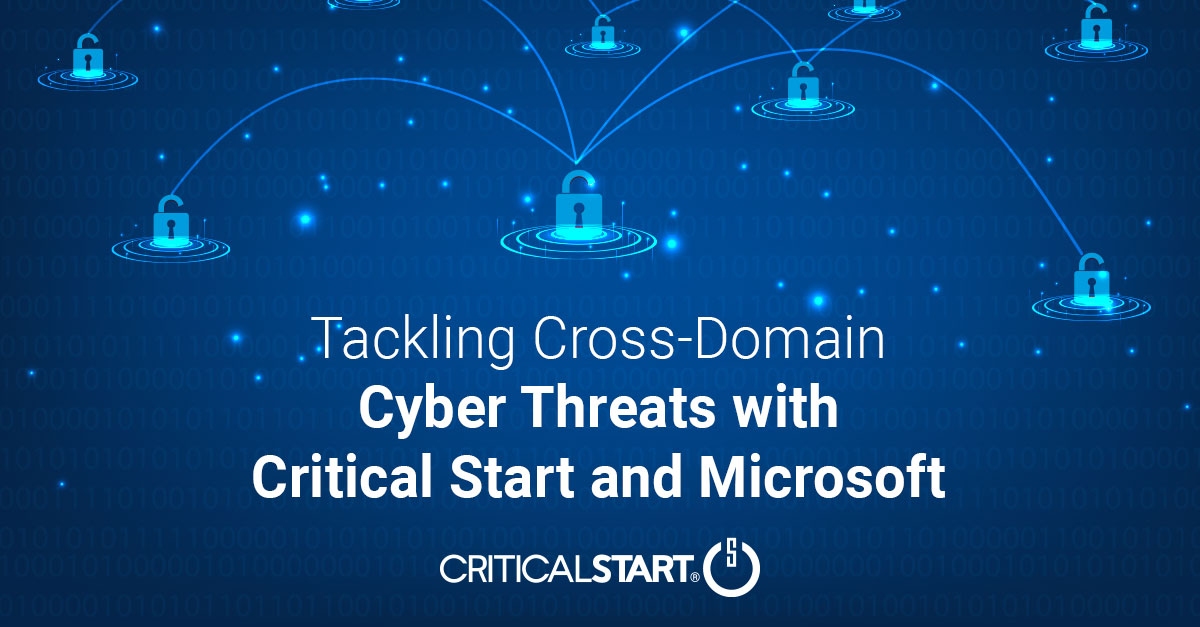Tackling Cross-Domain Cyber Threats: Microsoft XDR & Critical Start MDR to the Rescue

Let’s face it, in our ever-growing digital world, cybersecurity is a big deal. A multi-trillion-dollar big deal! Cybercriminals are getting craftier, using multi-stage attacks and cross-domain techniques that can make life difficult for cybersecurity operations. To add to that, Security Operations Center (SOC) teams are often in a spot where they are very much behind the 8-ball staff wise, skillset wise, tool wise, or worse, all the above. But don’t worry – we’re here to discuss how Microsoft’s Extended Detection and Response (XDR) and Critical Start’s Managed Detection and Response (MDR) can help keep your digital assets safe. You ready? Let’s go!
Section 1: The Tough Stuff – Multi-Stage Attacks
Multi-stage attacks are like a game of hide-and-seek that cybercriminals play with your security systems. We are often trained to look as far left as possible in the attack and assume it MUST be from an email, right!? Not always! Multi-stage attacks are tricky. Here’s why they’re so tricky, along with four common causes of these attacks:
- Hard to spot: These attacks often sneak under the radar, avoiding security alerts.
- Evasion masters: Cybercriminals use clever tactics like encryption and obfuscation to slip past security tools.
- Lateral moves: Once inside a network, attackers can hop from one vulnerability to another, making it hard to track their moves and limit damage. By the way, this happens in a matter of seconds.
- Limited visibility: Traditional security tools might not see the whole picture, making it tough to understand the full attack lifecycle, or there’s a siloed disconnect between tools and teams.
Common Causes of Multi-Stage Attacks:
- Phishing and social engineering: Attackers often use deceptive tactics, like fake emails or websites, to trick users into revealing sensitive information or downloading malware.
- Exploiting known vulnerabilities: Cybercriminals take advantage of security flaws in software and hardware that haven’t been patched or updated, allowing them to infiltrate systems.
- Compromised credentials: Stolen or weak user credentials can provide attackers with easy access to networks and sensitive data.
- Advanced Persistent Threats (APTs): Highly skilled and well-funded adversaries often use multi-stage attacks to infiltrate and establish a foothold in target networks, often remaining undetected for extended periods.
Section 2: Microsoft XDR – The Security Toolbelt for Cross-Domain Attacks
Microsoft’s Extended Detection and Response (XDR) is like a superhero that swoops in to protect you from cross-domain attacks. Here’s how XDR saves the day:
- Integrated security: XDR brings together data from different security domains, like endpoints, identities, applications, network infrastructure, and more, giving you a complete view and protection of your digital kingdom.
- Quick on its feet: Microsoft XDR uses advanced analytics and machine learning to identify and respond to threats in real time.
- Connecting the dots: XDR analyzes data across domains to spot attack patterns that might otherwise go unnoticed.
- Speedy response: Microsoft XDR helps security teams act fast, reducing the damage caused by successful attacks.
Section 3: Critical Start MDR – The Perfect Sidekick for Microsoft XDR
Critical Start’s Managed Detection and Response (MDR) service is the ideal sidekick to enhance Microsoft XDR’s capabilities. Together, they make an unstoppable duo:
- Expert squad: Critical Start’s MDR team is packed with cybersecurity pros, ensuring that Microsoft XDR is set up just right for maximum protection.
- Zero-
- Always on guard: Critical Start’s MDR service keeps a watchful eye on your security environment 24/7, ready to tackle threats as they emerge.
- Proactive threat hunting: The MDR team at Critical Start actively hunts down threats, stopping potential attacks before they can cause harm.
- Top-notch support: If a security breach happens, Critical Start’s MDR team is there to help you respond effectively and minimize damage.
Conclusion
Dealing with multi-stage and cross-domain attacks can be a real headache, but Microsoft’s Extended Detection and Response (XDR) is here to help. Internally operationalizing tools can be tough, upskilling your team can be a nonstop uphill battle, and ensuring processing change at the pace of the threat landscape can be nearly impossible. But when you pair M365 Defender + XDR with Critical Start’s Managed Detection and Response (MDR) service, you’ve got a powerful combo to keep your digital assets safe. So go on, team up with Microsoft XDR and Critical Start MDR to outsmart those crafty cybercriminals!
If you’d like to chat in person, come visit Critical Start’s Booth #860 in the South Hall at RSA on April 24th – 27th. Not only will you get to see the new Critical Start dashboards and hear about new product integrations from an expert team, but you’ll also have the chance to be part of the Critical Start mosaic wall and take home a custom sketch! Come on by, and let’s talk Microsoft and MDR.

Senior Technical Support Specialist II – Security + Identity, Microsoft
Trevor has worked in IT for over 15 years, starting out with SMS 2003 -> SCCM 2006 + Active Directory -> SCCM all new flavors -> Intune and Cybersecurity, and pretty much everything in-between the user, the keyboard, their authentications, and authorizations! Trevor started his time at Microsoft within the Services organization as a vendor PFE, got brought in internally and remained a PFE/CE for 3.5 years where he delivered in the Cybersecurity solutions space. Trevor swiftly moved into the Cloud Solution Architect role and has always had a passion to “lean as left” as possible in the cycle, remaining close to the customer.
You may also be interested in…
Stay Connected on Today’s Cyber Threat Landscape
RELATED RESOURCES
![]() Datasheet
DatasheetManaged Detection and Response Services
Human-Driven MDR Enhanced With Proactive Cybersecurity Intelligence Increase your security operation...![]() Video
VideoStop Drowning in Logs: How Tailored Log Management and Premier Threat Detection Keep You Afloat
Are you overwhelmed by security logs and complex threat detection? Watch our on-demand webinar to le...![]() Datasheet
DatasheetCritical Start MDR Services for Operational Technology
Gain 24x7x365 visibility and threat detection across Information Technology (IT) and Operational Tec...
RESOURCE CATEGORIES
-
- Consumer Education(40)
- Consumer Stories(2)
- Cybersecurity Consulting(7)
- Data Breaches(15)
- Data Privacy(43)
- Incident Response(2)
- Interview(51)
- MDR Services(78)
- MobileSOC(9)
- News(5)
- Press Release(93)
- Research Report(11)
- Security Assessments(4)
- Thought Leadership(19)
- Threat Hunting(3)
- Video(1)
- Vulnerability Disclosure(1)


